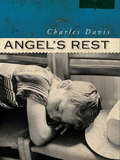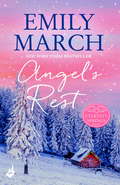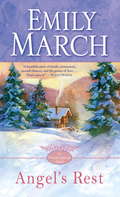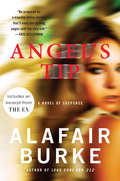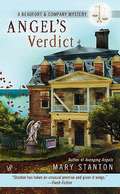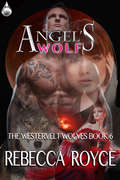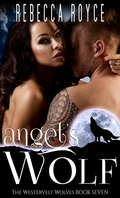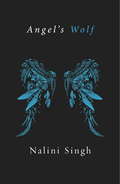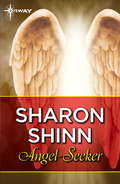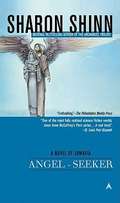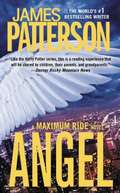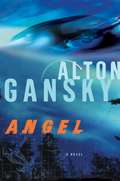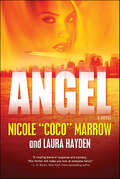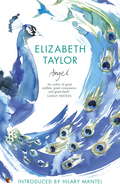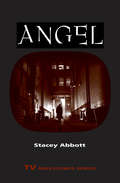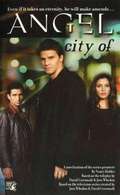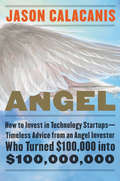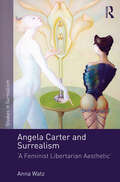- Table View
- List View
Angel's Rest
by Charles DavisGrowing up in Virginia's Allegheny Mountains, eleven-year-old Charlie York lives at the foot of an endless peak called Angel's Rest, a place his momma told him angels rested before coming down to help folks. In 1967 his town was a poor boy's paradise...until a shotgun blast killed Charlie's father and put his mother on trial for murder.For mysterious reasons, his mother entrusts his care to an old black man named Lacy Albert Coe. Lacy tells simple stories about the good and the bad that compose life's sweetest music. But when a reclusive Korean War veteran is linked to his father's death and Lacy is victimized by hate crimes, Charlie hears only silence. It's not until Charlie embarks on a dangerous midnight journey pitting him against his darkest fears that he finally hears his own song playing out.
Angel's Rest: A heartwarming, uplifting, feel-good romance series (Eternity Springs)
by Emily MarchIf you love Robyn Carr's Virgin River, don't miss Emily March's warm, uplifting Eternity Springs series!Angel's Rest is the first novel in New York Times bestselling author Emily March's warm and uplifting romance series about a small town with a big heart. For fans of Debbie Macomber, Holly Martin and Sheryl Woods.Gabriel Callahan has lost everything that mattered. All he wants is solitude on an isolated mountain estate. Instead, he gets a neighbour. Vibrant, no-nonsense Nic Sullivan is Eternity Springs' veterinarian, and she has an uncanny plan to lure this talented architect back to the world of the living. First with a dog, next with a renovation project, and, finally, with a night of passion that ends with a surprise. Now a man still raw from tragedy must face the biggest struggle of his heart. Can he forgive himself and believe in the power of second chances? Dare he trust in the promise of a future and a brand-new family here in Eternity Springs?Escape to Eternity Springs, a little piece of heaven in the Colorado Rockies, with the other books in the series, Hummingbird Lake, Heartache Falls, Mistletoe Mine, Lover's Leap, Nightingale Way, Reflection Point, Miracle Road, Dreamweaver Trail, Teardrop Lane, Heartsong Cottage, Reunion Pass, Christmas In Eternity Springs.
Angel's Rest: An Eternity Springs Novel (Eternity Springs #1)
by Emily MarchBeloved author Emily March returns with a warm and uplifting new novel about a small town with a big heart. Welcome to Eternity Springs, a little piece of heaven in the Colorado Rockies. Gabriel Callahan has lost everything that mattered. All he wants is solitude on an isolated mountain estate. Instead, he gets a neighbor. Vibrant, no-nonsense Nic Sullivan is Eternity Springs#x19; veterinarian, and she has an uncanny plan to lure this talented architect back to the world of the living. First with a dog, next with a renovation project, and, finally, with a night of passion that ends with a surprise. Now a man still raw from tragedy must face the biggest struggle of his heart. Can he forgive himself and believe in the power of second chances? Dare he trust in the promise of a future and a brand-new family here in Eternity Springs?
Angel's Roost
by Janet SpaethChristian romance set in North Dakota from Thanksgiving to New Year's Day.
Angel's Tip
by Alafair BurkeThrilled to spend the final hours of her spring break in the VIP room of an elite Manhattan club, fresh-faced Indiana college student Chelsea Hart remains behind when her girlfriends call it a night. The next morning, joggers find her body in East River Park, her blond hair brutally hacked off.NYPD Detective Ellie Hatcher believes the group of privileged men last seen plying Chelsea with free-flowing alcohol most likely includes a murderer. But after building a tight case against a young hedge-fund manager, Ellie has her doubts, because Chelsea's slaying is eerily similar to three other murders from nearly a decade ago. Continuing the investigation long after the department brass is satisfied with their case, hard-headed Ellie plunges into a late-night party world of conspicuous wealth and hedonistic consumption to catch the real killer--unaware that a psychopath is watching her every move...and eager to kill again.t the trial against Myers. But Ellie has her doubts. Chelsea's murder is eerily similar to three other deaths that occurred nearly a decade ago: the victims were young, female, and in each case, the killer had taken her hair as a souvenir. Ellie's investigation pulls her into a late-night world of exclusive clubs, conspicuous wealth, and hedonistic consumption. And her search for the truth not only pits her against her fellow cops but also places her under the watchful eye of a psychopath eager to add the prideful young female detective to his list. Wrenching and suspenseful, Angel's Tip is an electric thriller that offers a voyeuristic glimpse into the glamorous but dangerous world of New York nightlife. This stunning whodunit proves yet again that Alafair Burke "knows when and how to drop clues to keep readers at her mercy" (Entertainment Weekly).
Angel's Verdict
by Mary StantonCelestial advocate Brianna Winston-Beaufort is eager to set aside handling appeals for condemned souls and get back to practicing law in the land of the living. Three months after taking over the family practice Bree jumps at the opportunity to work for an earthly client. But when elderly actress Justine Coville walks into Beaufort & Company's office to make changes to her will, she drags Bree right back into a whole other-world of troubles.
Angel's Wolf (Westervelt Wolves #6)
by Rebecca RoyceWitches, wolves, and murderous rage. The Westervelt wolves are embroiled in a bitter war. Book 6 of this sweeping series finds the daughter of former alpha Kendrick Kane in a battle for her very life. If there is any hope of saving the pack, Angel Kane and Parker Liberty must run head long into danger and face an evil determined to destroy them all.Angel Kane has always known who her family was and why she was hidden away from them in New Orleans. Now on the run, the last thing she wants is anything that could potentially get in the way of the plan she’s made for herself. That is, until she walks into a truck stop in New Jersey and encounters Parker Liberty—the wolf fate has picked out to be her perfect mate. Parker Liberty hasn’t uttered a word in almost forty years. Not since the horrible day he watched his father murder his mother on the island of Westervelt. He ignores his inner wolf and contents himself with expressing his inner emotions through his tattoos. But when a pair of witches almost kill Angel, he will return to Westervelt to save her.Meanwhile, Westervelt is under constant attack from Kendrick Kane, the pack's former Alpha, whose evil knows no bounds. His ultimate goal is to see all of his children dead --and that includes his daughter, Angel. It is questionable whether the Westervelt pack can even survive the week. Angel and Parker’s arrival will either turn the tide of the war or end the pack forever.
Angel's Wolf (Westervelt Wolves #7)
by Rebecca RoyceAngel Kane has always known who her family was and why she was hidden away from them in New Orleans. Now on the run, the last thing she wants is anything that could potentially get in the way of the plan she’s made for herself. That is, until she walks into a truck stop in New Jersey and encounters Parker Liberty—the wolf fate has picked out to be her perfect mate. Parker Liberty hasn’t uttered a word in almost forty years. Not since the horrible day he watched his father murder his mother on the island of Westervelt. He ignores his inner wolf and contents himself with expressing his inner emotions through his tattoos. But when a pair of witches almost kill Angel, he will return to Westervelt to save her. Meanwhile, Westervelt is under constant attack from Kendrick Kane, the pack's former Alpha, whose evil knows no bounds. His ultimate goal is to see all of his children dead --and that includes his daughter, Angel. It is questionable whether the Westervelt pack can even survive the week. Angel and Parker’s arrival will either turn the tide of the war or end the pack forever.
Angel's Wolf: A Guild Hunter Novella (The Guild Hunter Series)
by Nalini SinghWarrior angels, vampire hunters, and angels gone bad heat up this altogether sizzling paranormal alternate universe, from the bestselling author Nalini Singh.Angels' Wolf is a tale of flirtation and danger set in the Guild Hunter world. Noel has been promoted, but in the Guild Hunter world that's not always as positive as it sounds. And now that he's working with the beautiful, dangerous, seductive Nimra there are a whole host of new risks he has to contend with . . .Nimra is drawn to the mysterious Noel, sent to her by an angel, defiant and intense and oh-so-intriguing. Is their an alliance to be forged between them, or is it a matter of time before one of them becomes the others prey . . . This is a compelling, sexy addition to the Guild Hunter universe.
Angel-Seeker
by Sharon ShinnThe women who craved the attention of of angels were known as angel-seekers, a term used with awe by some - and scorn by others...Elizabeth was born to wealth, but circumstances forced her to live as a servant in her cousin's household. Determined to change her life, she travels to the town of Cedar Hills, hoping that an angel will take notice of her and take her as his own. Rebekah is a daughter of the Jansai tripe, raised to hate angels. But when she finds an injured angel near her village, she defies her upbringing to care for him.In time, these two women, whose paths will cross, will both find what they long for, in surprising - and dangerous - ways...
Angel-Seeker (Samaria #5)
by Sharon ShinnThe award-winning author returns to Samaria in this richly romantic tale that begins where Archangel left off. In that time, the women who craved the attention of angels were known as angel-seekers, a term used with awe by some--and scorn by others.
Angel: A Maximum Ride Novel (Maximum Ride #7)
by James PattersonMax Ride and her best friends are up against a deadly force, but Fang is gone just when they need him most. Will they be ready for the ultimate showdown? Max Ride and her best friends have always had one another's backs-no matter what. Living on the edge as fugitives, they never had a choice. But now they're up against a deadly force that's racing across the globe, and just when they need him the most, Fang is gone. He's creating his own gang that will replace everyone-including Max. Max is heartbroken over losing Fang, her soul mate. Her closest friend. But with Dylan ready and willing to fight by her side, and she can no longer deny that his incredible intensity draws her in. Max, Dylan, and the rest of their friends must soon join forces with Fang and his new gang for an explosive showdown in Paris that's unlike anything you've ever imagined...or read.
Angel: A Novel
by Alton L GanskyA wise stranger has come to save our world. But is he too good to be true?An earthquake shakes Southern California, setting the stage for the appearance of Aster a stranger from a world far from our own. Miracles happen around him, spectacular promises are made, and wisdom flows from his lips. He says he has come to complete our knowledge, to explain our beginnings, and to correct our spiritual errors. And the world is ready to receive him: politicians seek his advice, religious leaders wish to call him friend, scientists want to study him, and philosophers wish to debate him.But not everything is what it seems. This messenger seems too good to be believed. Priscilla Simms, an investigatory journalist, is the only one close enough to the stranger to get at the truth. But unraveling the truth may cost her reputation, and maybe even her life.
Angel: A Novel
by Nicole "Coco" Marrow Laura HaydenA beautiful woman awakens on a plane and discovers that things are going terribly wrong. The plane is about to crash into the Hudson River…and she can't even remember her own name.After she survives the crash, the airline determines that her name is Angela Sands. But she has no idea who she really is.Reporter Dante Kearns is fascinated by the woman the media dubs "the Angel of the Hudson," especially once he discovers her shocking secret. Angela can hear voices in her head—the thoughts of all men around her. And when a man gets close, her face and form change into the woman of his dreams.Who is Angela? And why does she believe that she was murdered before she woke up on that plane in a stranger's body? Together, Angela and Dante are going to find answers, even if they have to bring down a killer to do so.Nicole "Coco" Marrow, wife of Ice-T, keeps readers guessing with her pulse-pounding debut novel.At the Publisher's request, this title is being sold without Digital Rights Management Software (DRM) applied.
Angel: A Novel (Charnwood Large Print Ser.)
by Barbara Taylor BradfordA saga of friendship and fame, secrets, and success from the #1 New York Times–bestselling author of A Woman of Substance. Orphaned at a young age, the lives of Rosie, Gavin, Nell, and Kevin are irrevocably intertwined. Rising from poverty, all four go on to stunning success: Rosie as an award-winning costume designer; Gavin as a world-renowned Hollywood actor; Nell as the head of a global public relations company; and Kevin as the head of the NYPD Crime Intelligence Commission and a leader in the fight against organized crime. Told with the broad scope and narrative power characteristic of Barbara Taylor Bradford, this book is the story of a family formed by fortune, not blood, as they lose their innocence, follow their passions, triumph over adversity, and ultimately transform their own lives. Praise for Barbara Taylor Bradford and her novels &“Few novelists are as consummate as Barbara Taylor Bradford at keeping the reader turning the page.&” —The Guardian &“Pure gold.&” —Cosmopolitan &“An extravagant, absorbing novel of love, courage, ambition, war, death and passion.&” —The New York Times &“The storyteller of substance.&” —The Times (London) &“A long, satisfying novel of money, power, passion and revenge set against the sweep of 20th century history.&” —Los Angeles Times &“A wonderfully entertaining novel.&” —The Denver Post &“Legions of readers will be satisfied by the romantic fortunes of the cultured, wealthy and powerful people she evokes.&” —Publishers Weekly
Angel: A Virago Modern Classic (Virago Modern Classics #1)
by Elizabeth TaylorINTRODUCED BY HILARY MANTELElizabeth Taylor is finally being recognised as an important British author: an author of great subtlety, great compassion and great depth - Sarah WatersWriting stories that are extravagant and fanciful, fifteen-year old Angel retreats to a world of romance, escaping the drabness of provincial life. She knows she is different, that she is destined to become a feted authoress, owner of great riches and of Paradise House . . .After reading The Lady Irania, publishers Brace and Gilchrist are certain the novel will be a success, in spite of - perhaps because of - its overblown style. But they are curious as to who could have written such a book - an elderly lady, romanticising behind lace curtains? A mustachioed rogue? They were not expecting it to be the pale, serious teenage girl, sitting before them without a hint of irony in her soul. *'Her stories remain with one, indelibly, as though they had been some turning-point in one's own experience' Elizabeth Bowen 'No writer has described the English middle classes with more gently devastating accuracy' Rebecca Abrams, Spectator
Angel: A Virago Modern Classic (Vmc Ser. #649)
by Elizabeth TaylorINTRODUCED BY HILARY MANTELElizabeth Taylor is finally being recognised as an important British author: an author of great subtlety, great compassion and great depth - Sarah WatersWriting stories that are extravagant and fanciful, fifteen-year old Angel retreats to a world of romance, escaping the drabness of provincial life. She knows she is different, that she is destined to become a feted authoress, owner of great riches and of Paradise House . . .After reading The Lady Irania, publishers Brace and Gilchrist are certain the novel will be a success, in spite of - perhaps because of - its overblown style. But they are curious as to who could have written such a book - an elderly lady, romanticising behind lace curtains? A mustachioed rogue? They were not expecting it to be the pale, serious teenage girl, sitting before them without a hint of irony in her soul. *'Her stories remain with one, indelibly, as though they had been some turning-point in one's own experience' Elizabeth Bowen'No writer has described the English middle classes with more gently devastating accuracy' Rebecca Abrams, Spectator
Angel: Angel
by Stacey AbbottExamines the innovative approach to genre, aesthetics, narrative, and the representation of masculinity in the television series Angel.
Angel: City Of
by Nancy Holder Joss WhedonTo distance himself from Buffy and the pain of love that can never be, Angel has moved to Los Angeles, ready to take on all the evil the City of Angels can throw at him. Alongside him in the fight against darkness is an unlikely ally - Cordelia Chase.
Angel: How to Invest in Technology Startups—Timeless Advice from an Angel Investor Who Turned $100,000 into $100,000,000
by Jason CalacanisOne of Silicon Valley’s most successful angel investors shares his rules for investing in startups.There are two ways to make money in startups: create something valuable—or invest in the people that are creating valuable things.Over the past twenty-five years, Jason Calacanis has made a fortune investing in creators, spotting and helping build and fund a number of successful technology startups—investments that have earned him tens of millions of dollars. Now, in this enlightening guide that is sure to become the bible for twenty-first century investors, Calacanis takes potential angels step-by-step through his proven method of creating massive wealth: startups.As Calacanis makes clear, you can get rich—even if you came from humble beginnings (his dad was a bartender, his mom a nurse), didn’t go to the right schools, and weren’t a top student. The trick is learning how angel investors think. Calacanis takes you inside the minds of these successful moneymen, helping you understand how they prioritize and make the decisions that have resulted in phenomenal profits. He guides you step by step through the process, revealing how leading investors evaluate new ventures, calculating the risks and rewards, and explains how the best startups leverage relationships with angel investors for the best results. Whether you’re an aspiring investor or a budding entrepreneur, Angel will inspire and educate you on all the ins of outs. Buckle up for a wild ride into the world of angel investing!
AngelList
by Liz Kind Ramana NandaIn early 2010, Naval Ravikant and Babak Nivi posted a list of angel investors on the Venture Hacks blog as a resource for founders looking for funding prior to seeking venture capital. The list quickly evolved into AngelList, a separate matchmaking platform for founders and investors to make early stage fundraising more efficient. By June 2013, AngelList had garnered substantial media attention, and was used by many high profile angel investors and venture capitalists. It had approximately 100,000 startups and 18,000 accredited investors. Since the site was launched, almost 40 startups on AngelList had been acquired, and over 2,000 startups had been funded. For most entrepreneurs, posting a profile on AngelList had become as commonplace as setting up a personal profile on Facebook or LinkedIn. Most recently, the site added Invest Online, a new product that in partnership with SecondMarket, allowed accredited investors to make small investments-as low as $1,000-in startups at the same terms as larger investors.While the co-founders were proud of AngelList's growth, as of June 2013, they were not charging for its use and had not yet determined its business model. Ravikant and Nivi wondered if they should reconsider and have AngelList apply for broker dealer status so it could charge transaction fees, but they were reluctant to enter what they considered a regulatory minefield. The recently passed JOBS Act was expected to relax constraints around crowdfunding, and Nivi and Ravikant knew that would be a logical extension for AngelList as well. Finally, they wondered if they should avoid any potential regulatory issues altogether and instead focus on generating revenue primarily from recruiting and other ancillary services.
AngelList in 2017
by Ramana Nanda Robert F. WhiteAngelList in 2017 by Ramana Nanda, Robert F. White and Liz Kind
Angela Carter and Decadence
by Maggie TonkinBy reading key Carter texts alongside their Decadent intertexts, Tonkin interrogates the claim that Carter was in thrall to a fetishistic aesthetic antithetical to her feminism. Through historical contextualization of the woman-as-doll, muse and femme fatale, Tonkin tests Carter's own description of her fiction as a form of literary criticism.
Angela Carter and Surrealism: 'A Feminist Libertarian Aesthetic' (Studies in Surrealism)
by Anna WatzIn 1972, Angela Carter translated Xavière Gauthier’s ground-breaking feminist critique of the surrealist movement, Surréalisme et sexualité (1971). Although the translation was never published, the project at once confirmed and consolidated Carter’s previous interest in surrealism, representation, gender and desire and aided her formulation of a new surrealist-feminist aesthetic. Carter’s sustained engagement with surrealist aesthetics and politics as well as surrealist scholarship aptly demonstrates what is at stake for feminism at the intersection of avant-garde aesthetics and the representation of women and female desire. Drawing on previously unexplored archival material, such as typescripts, journals, and letters, Anna Watz’s study is the first to trace the full extent to which Carter’s writing was influenced by the surrealist movement and its critical heritage. Watz’s book is an important contribution to scholarship on Angela Carter as well as to contemporary feminist debates on surrealism, and will appeal to scholars across the fields of contemporary British fiction, feminism, and literary and visual surrealism.
Angela Carter and Western Philosophy
by Heidi YeandleThis book unearths Carter's deconstruction of the male-dominated discipline of Western thought. Revealing the extensive philosophical research that underpins Carter's intertextual work, this book offers new readings of her fiction in relation to a range of philosophical texts and ideas. By re-examining Carter's writing with reference to the archived collection of her notes that has recently become available at the British Library, Angela Carter and Western Philosophy puts forward new interpretations of Carter's writing practices. With chapters examining her allusions to Plato, Hobbes and Rousseau, Descartes, Locke and Hume, Wittgenstein and Ryle, as well as Kant and Sade, this book illuminates Carter's engagement with different areas of Western thought, and discusses how this shapes her portrayal of reality, identity, civilisation, and morality. Angela Carter and Western Philosophy will be of interest to researchers, lecturers, and students working on contemporary women's writing, philosophy and literature, and intertextual literary practices.
